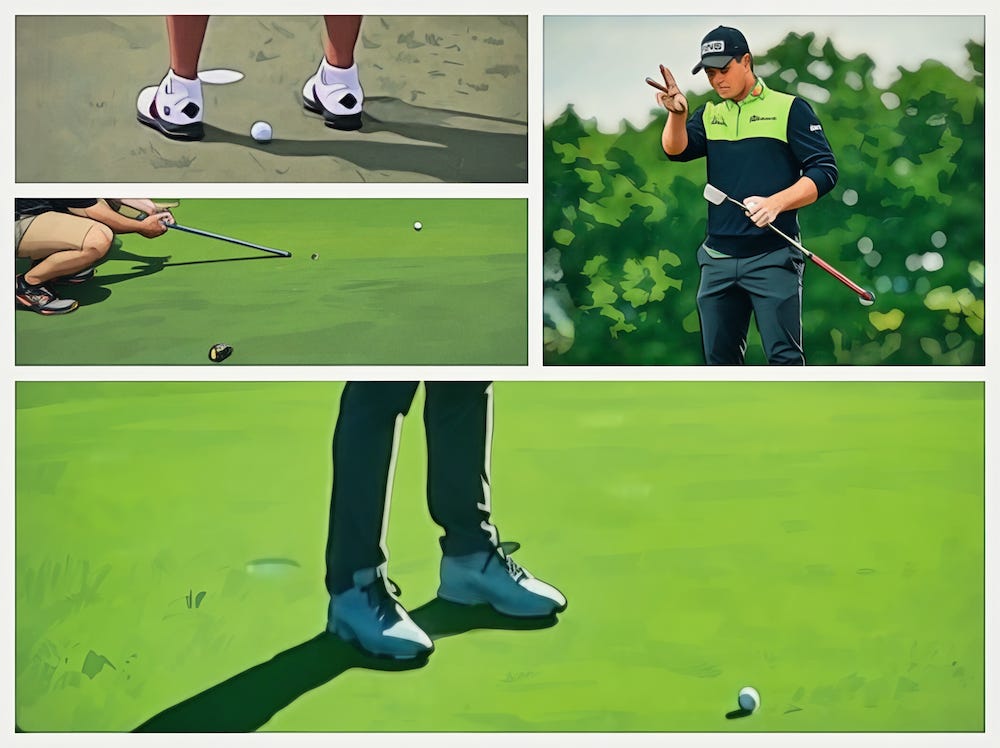Why Aimpoint Offends
The disregard for others has turned the green reading method into a poster child for slow play. That's the least of its offensive qualities.
On the unpublished, super-secret Top 100 Slow Play Culprits list, AimPoint falls somewhere in the second hundred. Sources say it’s hovering around obsessive-compulsive groove cleaning and backing off shots due to butterfly burps. Yet in early 2025, the goofy-looking green reading technique has vaulted into the spotlight as the ultimate pace-of-play killer. Not 7,600-yard courses, marble-fast greens, back-ups on tees, or players waiting for the wind they want.
The visual of golfers employing a cult-like symbol and straddling their line continues to go down like a bottle of Two-Buck Chuck. The 2025 vintage looks a C-List director playing cinematographer, followed by suggestions of a post-round field sobriety test or even the potential of an unexpected bowel discharge.
Since the method has been around for a while, what makes it so offensive in 2025?
For starters, the sense of rudeness to greenkeepers and fellow golfers has always separated AimPoint from previous green reading methods. The AimPoint act is no less bizarre than plumb-bobbing. But it receives far more vitriol thanks to the sight of able-bodied, 20/20 vision superjocks fueled by farm fresh eggs standing on meticulously-groomed greens, and then compressing their stiff-soled shoes into the innocent bents and poas of the world.
The act is particularly obnoxious when employed around the cup, that once-sacred space now apparently fair game in a world where players regularly press and poke the club down behind their golf ball to test the lie. But those antiquated play-it-as-it-lies values were part of the pre-2019 days before the governing bodies decided soft golfers needed to pick and poke around the ball in fairways, bunkers, and even rocky creeks.
There would be no need to ban AimPoint in tournaments if pace-of-play policies were enforced. If a golfer wants to do 20 jumping jacks before a birdie putt—off the green, please—who cares? As long as they play their shot in under 40 seconds. But without fear of penalty, players have no incentive to play at a reasonable pace or care for the course.
Last weekend’s sight of A Lim Kim straddling a tap-in went viral for good reason. In addition to the silliness of needing assistance with such a short putt next to the hole, it was the inclination to start her pre-putt routine that illuminated the robotic nature of modern professional golf. The online mocking also highlighted the underlying hostility toward professional golf’s overreliance on science, technology, or what “the team” discovered in cobbling together data that dictates every move before a shot is struck. Fans are trying to convey that golf is less fun to watch unless players are still combining art, instinct, individual responsibility, and their immense skill to figure things out.
Putting was once a delicate art form, merging creativity and oddball techniques. Now, work on the greens appears to no longer offer the wild (and wonderfully weird) delicacy that contrasts with the intensities found in hitting full shots. Then throw in the occasional AimPointee, and it’s a reminder of the lost quirkiness when putting took place on slower greens.
Faster greens emphasize the mechanics designed to start the ball while reducing the beautiful melding of break, imagination, and touch. The willingness to look like a jackwagon employ AimPoint has been enhanced by the 2019 rule change, which allows for the repair of anything in one’s line. Players now assume that if the green can be repaired, then there is no reason to worry about the next group or even their playing partners. Someone else can clean up my indentations or any scuffs created from foot-humping around the line.
Even green-reading books were never this offensive. (Remember when players assured us those did not look bad or slow down play?)
The time spent relying on AimPoint pales compared to what the speed of the surfaces adds to the round’s duration. Those once-straight short putts on a green rolling 9-10 feet? They now feature a little break when greens are running 12-13 feet. In trying to protect par and the dignity of the membership, course setups have been known to cut holes on spots that require caution, even from 18 inches. With livelihoods on the line, pro golfers understandably take more time or even employ weird methods regardless of how silly they might look.
According to a 2017 USGA study of recreational golfers, every added foot of Stimpmeter speed increased pace-of-play by 6.4 seconds per player, per hole. This adds seven minutes per round per foot on the Stimp. This means a set of greens designed to be no more than nine on the Stimpmeter and now rolling at 13 feet will take nearly 30 minutes longer to play. Those are just the numbers for average chops who routinely give putts and sometimes fail to finish out the hole. Elite tournament golfers do not have that luxury.
Every year at The Open and AIG Women’s Open we see professionals play faster than in the other majors. The same bottlenecks and distance-related messes occur but links putting surfaces are 2-3 feet slower than everywhere else on the calendar. Players spend less time grinding on shorter putts.
The same USGA study found “that a 1-foot increase in green speed led to a significant decrease in golfer enjoyment based on survey results following their round.” Yet green speed has continued as an unfortunate priority throughout the sport. Most modern greens must be maintained at heights producing 11-12 on the Stimpmeter. Courses have purposely rebuilt greens to have such grasses in the name of smoother putting. So they soften contours to accommodate the new speeds.




